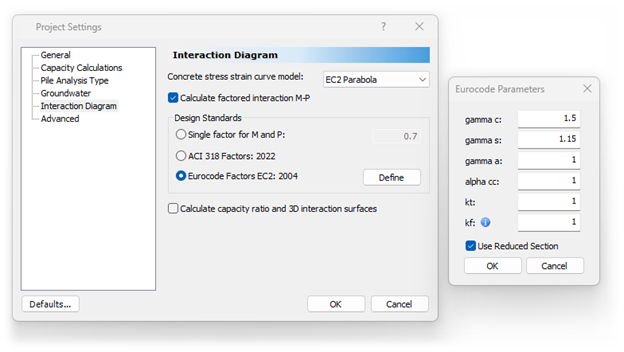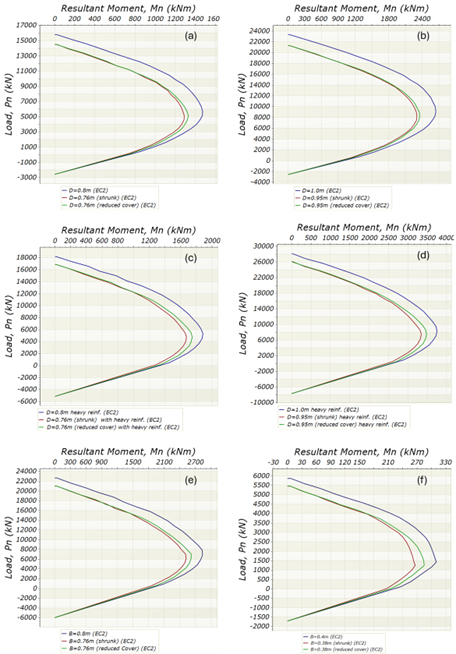Reduction of Pile Diameter According to Eurocode Requirements in RSPile
- Ahmed Mufty, Senior Geomechanics Specialist
The diameter reduction requirements in Eurocode 2 (EC2) can complicate even the most well-planned pile designs. Here, I’ll analyze specific gaps in the code, share insights from my discussions with European engineers, and demonstrate how RSPile considers section size reduction to address these issues.
Eurocode 2 (EN1992:2004) Sec. 2.3.4.2 clearly indicates:
If Dnom < 400 mm, D = Dnom - 20 mm
If 400 mm ≤ Dnom ≤ 1000 mm, D = 0.95Dnom
If Dnom > 1000 mm, D = Dnom - 50 mm
where Dnom is the is the nominal diameter of the pile section and D is the design diameter.
To explain the effect of size reduction and how to apply it, let us discuss this requirement first. At first glance, the requirement itself seems impractical for the following reasons:
- Most CIP piles are drilled in diameters greater than the nominal diameters, especially when using exact diameter buckets.
- The top part of the pile is usually cased during casting, and when the casing is lifted and removed, the remaining thickness is filled with concrete.
- All pile reinforcement cages are provided with enough spacers to centralize the cage and keep the cover as designed, and if the cover is less than the design cover, the installation will signal obstacles when lowering the cage into the hole.
- In most cases, pile drilling is checked with a caliper logging test to make sure that the size of the pile meets design specifications.
The requirement may make sense in CFA piles (continuous flight auger drilled piles) in which the engineer does not have control or a way to check the hole before casting. Also, it may be of some value if bentonite is used and a filter cake is expected to form, or if a couple millimeters from the outer edge of the concrete is contaminated.
Eurocode 2 missed specifying four things:
1. What should the designer do for rectangular piles (barrettes)? Barrettes have widths and breadths, not diameters. Should the designer base the reduction on each dimension separately, or a single reduction for all sides? Single reduction may have complications if you take the worst case and may not be enough if you take the less reduction. If the reduction is based on each side separately, the cover will not be the same in design and may need additional work for development and other issues.
2. The code also missed telling whether the reduction is only in the cover or shrinks the reinforcement cage towards the center, as Eurocode 2 asked for a reduction without specifying how it’s applied. For example, if the reduction is applied before the steel design, the cover for the pile section will be 75 mm or any other nominal cover specified in the design, leading to the steel bars being positioned closer to the center. Then the designer should decide whether the bars obtained from the smaller section should be distributed based on the original section or using an increased cover.
3. The code did not specify if the reduction is required for permanent foundation piles or should be applied to temporary piles as well, including those installed as shoring walls or reaction piles in testing.
4. EC2 did not specify whether the requirement is applied only for proportioning the section, or to be applied for the analysis of the piles under ULS or SLS loading conditions. If the latter is followed it will have consequences on the moment of inertia, leading to different axial load and bending moments, and it will affect the crack width and steel stress levels.
I discussed the problem with several pile designers from Europe:
Mr. Ako Umar, a distinguished geotechnical, structural tunnelling, and shoring designer in Germany, interpreted the code as to use new diameter to determine the reinforcement applying the design cover to the new section, which shrinks the steel cage and leads to a more conservative reinforcement percentage. He thinks that the provisional cover required should be maintained in all design calculations.
Other engineers had different views. Some designers around Europe, including Turkey and the UK, were against the reduction and did not apply it.
Dr. Wissam Al-Ani, the Principal Geotechnical Engineer at Aarsleff Ground Engineering working in the UK, was against the shrinking of reinforcement cage, and favored the reduction to be applied to the cover only, leading to a lesser effect on reinforcement amount assuming it will have less cost implication.
Dr. Salam Al-Sabah, Consultant at ARUP who has both an academic and professional career in Ireland, was also confused of the Eurocode item, and he assumed that the decision is to the designer and the country-based Annexure.
I also asked about the matter during a webinar from the Association of Geotechnical and Geoenvironmental Specialists (AGS) in the UK. The webinar was an introduction to the expected changes in Eurocode EN 1997 (EC7) and the presenters were specialists from the UK: Chris Raison (Raison Foster Associates), Matthew Baldwin (Independent Consultant), Stuart Hardy (Liang O’Rourke), and Andrew Bond (Geocentrix). They confirmed that the new Eurocode 1992 (EC2) will be amended for this item.
BS8004: 2015 has already discarded the EC2 requirement by allowing no reduction if the piles are executed following BS EN 1536: 2010, accurately, which is supposedly the case in most piling projects.
Concluding with that, the diameter reduction requirement of current EC2 is not encouraged to follow. Nevertheless, RSPile offers the user the choice to decrease the size or to keep the diameter or side lengths of the pile or barrette based on the Eurocode requirement.
How pile diameter reduction works in RSPile:
Users can check the reduction box at the Eurocode entries for the construction of interaction diagrams as shown in Fig.1.

In RSPile, the reduction is applied only to the cover reducing the pile concrete dimensions and not causing any shifting or relocation to the pile reinforcement bars.
The following example shows the differences in interaction diagrams, when reduction is applied. In all examples, concrete cylinder strength is taken as fck = 40 MPa, reinforcement steel yield strength fy = 500 MPa, original nominal cover to reinforcement 75 mm and because of the links of 10 mm in diameter, the clear nominal cover to the main reinforcement will be 85 mm . All bars used are of BS4449 25 mm diameter. The material partial factors are taken as 1.5 for the concrete and 1.15 for the steel. All other factors such ac, Kt, and Kf , are set to unity.
Example: Comparing the interaction diagrams for different pile shapes and sizes, different percentages of reinforcement, for three cases: original case where no size reduction is applied, reduced size by rescaling the reinforcement cage with new bar locations keeping the cover unchanged (shrunk cases), and finally a case where the pile is resized by reducing the cover without changing bar locations. Table 1 lists the details for these models and the results are shown in Figure 2 below.
The dimensions reduction followed the requirements of EC2.

At medium to large diameters, the interaction diagrams of the resized section with reduced cover and the shrunk section will be close to each other when the axial load is high, but they start to separate as the moment increases. In all cases, the shrunk section is more conservative than the reduced cover case (yielding less moment capacity).
Table 1. Pile sections, sizes, shapes, and size reduction.
Figure |
Section Shape |
Section Size (m) |
Reduced Size (m) |
Reinforcement Bars |
Reinforcement Percentage (%) |
Percentage After Size Reduction (%) |
Fig. 2 (a) |
Circular |
D = 0.8 |
0.76 |
12 T25 |
1.7122 |
1.2988 |
Fig. 2 (b) |
Circular |
D = 1.0 |
0.95 |
12 T25 |
0.7502 |
0.8312 |
Fig. 2 (c) |
Circular |
D = 0.8 |
0.76 |
24 T25 |
2.3444 |
2.5976 |
Fig. 2 (d) |
Circular |
D = 1.0 |
0.95 |
36 T25 |
2.2506 |
2.4937 |
Fig. 2 (e) |
Square |
D = 0.8 |
0.76 |
28 T25 |
2.1481 |
2.3802 |
Fig. 2 (f) |
Square |
D = 0.4 |
0.38 |
8 T25 |
2.4550 |
2.7202 |
The difference decreases as the original size of the pile increases. This is because the percentage of reduction is the same or constant, while the moment capacity lever arm has double effect on the moment capacity from summation of internal forces and the moment lever arm. And as the size goes below 400 mm, the percentage of reduction increases because the reduction remains constant for less sizes.
Comparing Figure 2(a) and Figure 2(b), we find that, in general, larger sized piles, also, will be relatively less affected by the decrease in section diameter or width compared to smaller sized sections. And as the diameter or size increases more than 1000 the reduction becomes constant, and the effect gets much less.
The effect of size reduction difference between the two methods is higher in square sections than in circular sections. Square sections have the same behavior regarding size effects. Compare Figure 2(e) with Figure 2(f).
Heavier reinforcement shows that the section gets more affected by the reduction and that the difference between the two methods increases. Compare Figure 2(c) with Figure 2(a) and Figure 2(d) with Figure 2(b).
Final thoughts:
While the Eurocode reduction requirements present several design challenges, RSPile streamlines the process by offering reduction and non-reduction options. Designers can create more accurate, code-compliant models with ease and better adapt to modern pile design and construction practices.
References
Eurocode 1992:2004
BS 8004: 2015
